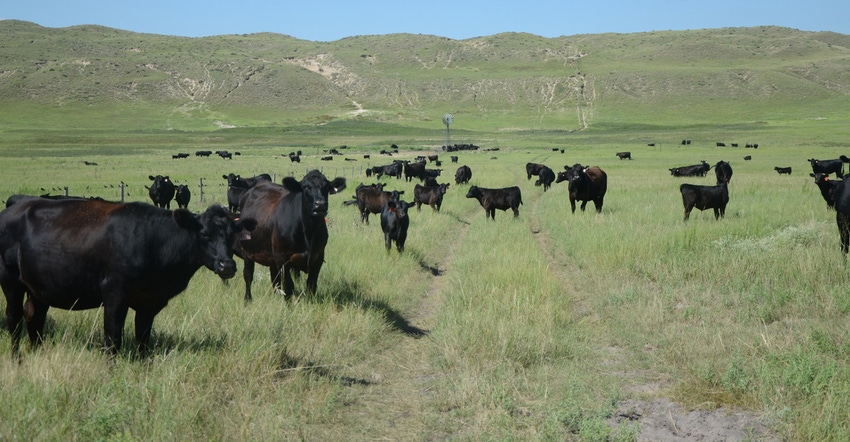April 11, 2019

By Jerry Volesky and Mitch Stephenson
The start of the growing season will soon be here, and it's time to finish up grazing and forage plans for the upcoming year.
Rangeland and pasture production were good in 2018, with many areas of Nebraska seeing production at 10% to 30% above average. This, of course, was the result of abundant and timely rains during the spring into midsummer.
Although long-range weather forecasts always have some uncertainty, the Climate Prediction Center currently indicates weak El Nino conditions in the Pacific Ocean. Historically, this has resulted in favorable spring and early-summer precipitation.
April precipitation and soil moisture are the basis for the initial growth of cool-season pasture grasses, but these species produce most of their growth during May. April and May precipitation, as well as temperature, are the two primary factors that might affect spring pasture growth and turnout dates.
Warm-season grasses generally initiate growth in May, with rapid accumulation of growth in late June and July. Because of the lower water-holding capacity of sandy soils, the frequency or length of time between rainfall events can be critical, especially when warm-season grasses put on most of their growth in June and early July.
A forecasting tool released last year, Grass-Cast, provides information on estimated increases or decreases in total plant production based on current weather projections into the growing season.
What to plan for
Grazing plans should include projected cattle numbers (or stocking rates), turnout dates and a pasture-use sequence for multiple pasture rotations. For livestock producers using various types of rotational grazing strategies, it's important to review grazing records from the previous years when planning the rotation sequence for 2019.
Consideration should be given to when the time or period of grazing occurred in the previous years and the amount of residual forage in that pasture from the previous year. Plans should adjust the schedule to avoid grazing the same pasture at the same time period in consecutive years.
As expected, there is a strong correlation between spring and early-summer precipitation and pasture productivity. In a mixed cool- and warm-season grass rangeland such as the Sandhills, 70% of the season's total production can occur by July 1.
Rainfall in late July or August generally doesn't contribute to substantial growth for that season, but it slows maturation of warm-season grasses and may benefit some fall growth of cool-season species.
Spring also is a good time to review or update drought plans. A drought plan can have varying levels of detail and complexity and can be customized to fit the specific needs of the operation. Some plans place an emphasis on critical-decision or trigger dates — when one evaluates total local precipitation up to that date.
On May 1, for example, a producer could determine their total April precipitation or the total effective precipitation since the previous fall and compare that with long-term averages for the area. If precipitation totals are significantly below the averages, that could trigger a choice of several possible management actions such as an extended period of feeding hay or culling of some livestock before turnout.
These actions should be adjusted to account for varying levels of expected drought. Other important dates may include May 15, June 1, June 15 and July 1.
Annual forage options
It's also a good time to finalize plans for planting spring or summer annual forage crops that might be grazed, hayed or harvested as silage to replenish feed supplies. This includes selecting the forage crop type, fields that will be planted, identifying seed sources and ordering the seed.
Oats, spring triticale and barley are annual cereal grains that can be planted from late March to early April to produce forage that can be grazed beginning in mid- to late May or harvested for hay or silage in late June or early July.
Cereal crop growth is rapid in late May and early June, requiring good grazing management and proper stocking rates to efficiently harvest the forage.
Forage peas, a legume, can be mixed with spring cereals to reduce nitrogen fertilizer needed while maintaining or improving protein levels of the harvested crop. However, in drier climates, forage peas may not significantly increase forage protein levels compared with an oat monoculture because of limited forage pea growth.
When selecting a spring cereal to plant, give preference to varieties selected for forage production. Select hooded or awnless varieties of barley if the crop is going to be harvested as hay. The quality of the forage produced from spring cereals depends on the stage of maturity at harvest. As maturity increases, quality rapidly declines.
The optimum compromise between quality and yield generally occurs shortly after boot to early heading stages. Dry matter produced per acre generally increases 10% to 20% from the boot to early heading stages.
Primary warm-season or summer annual forages include sudangrass, forage sorghum, sorghum-sudangrass hybrids, and pearl and foxtail millet. For warm-season species, soil temperatures at planting should consistently be at 60 to 65 degrees F — typically reached by late May.
These warm-season annuals also could be planted anytime up to early August and still produce forage but will produce more biomass with earlier planting dates.
The NebGuide, "Utilizing Annual Forages with Limited Irrigation for Beef Cattle During and Following Drought," includes information on using annual forages during and after drought.
Volesky is a Nebraska Extension range and forage specialist, and Stephenson is a UNL range management specialist.
This report comes from UNL BeefWatch, which is solely responsible for the information provided and is wholly owned by the source. Informa Business Media and all its subsidiaries are not responsible for any of the content contained in this information asset.
You May Also Like




